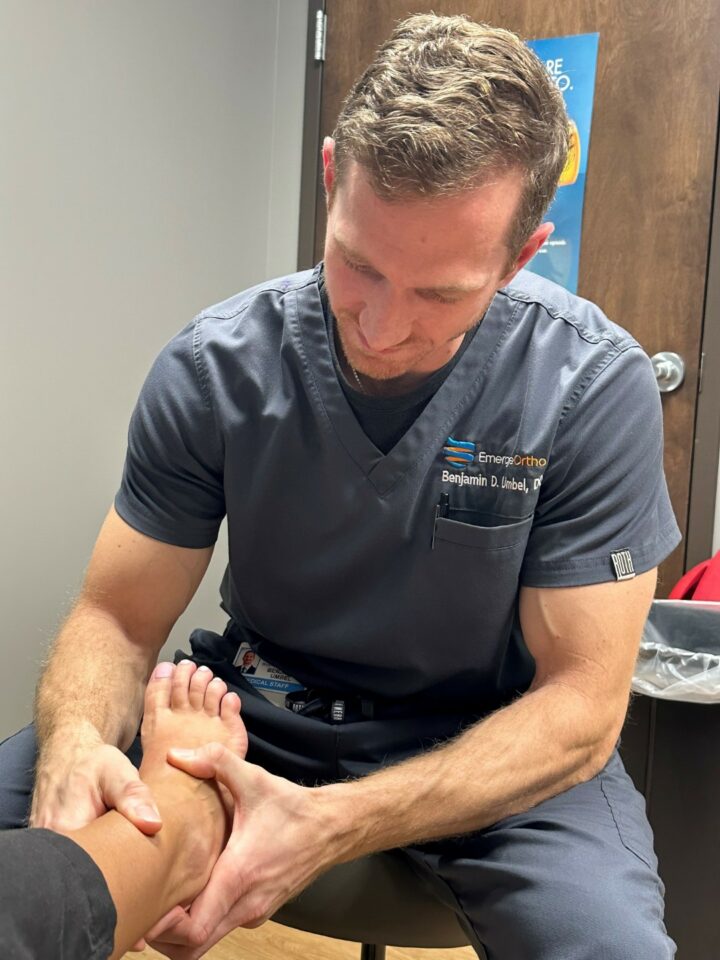
A stress fracture in the foot can be painful and keep you from being active and playing the sports you enjoy. It can also be difficult to distinguish from other types of foot pain. Learn more about what a stress fracture feels like and what to do if you think you have one.
What Is a Stress Fracture?
“Stress injuries” represent a spectrum of overuse conditions that affect the bones, mostly the bones of the lower extremities, as a result of overuse (i.e. athletes). This ranges from inflammation in the bone to a complete fracture.
A stress fracture represents a more severe injury along this spectrum. It can be defined as a small crack in the bone caused by repeated mechanical stress.
When you engage in certain activities, especially excessive or high-impact, weight-bearing exercises like running or jumping, your bone tissue can become inflamed and weaken, resulting in injury. Downtime and rest allow the bone to heal in between activities.
When you do not give the bone enough time to heal and continue to put stress on it, this results in ongoing inflammation of the bone and may result in a fracture.
A stress fracture, or stress reaction might begin as a painful bruise in the bone and can be associated with localized swelling. It can develop into an actual fracture if you ignore the pain and continue with your usual activities.
How Do You Get a Stress Fracture in the Foot?
 Repeatedly overloading the bones in your feet without adequate rest and recovery time can lead to a stress fracture. A few factors can lead to stress fractures:
Repeatedly overloading the bones in your feet without adequate rest and recovery time can lead to a stress fracture. A few factors can lead to stress fractures:
Engaging in an activity more frequently (overuse). For instance, increasing your running once a week to five times per week in a short period of time.
Increasing the intensity or duration of the activity, for example, running longer or faster than normal.
Changing an aspect of the activity, like going from running outside to running on a treadmill
If you do not make these increases gradually and with enough recovery time, you may experience a stress injury to the bone. The bones of the feet are particularly vulnerable to stress fractures because they bear so much of the body’s weight.
Any exercise that involves putting weight on the feet can cause a stress injury, including walking, hiking, running, or any sports that involve running and jumping.
What Does a Stress Fracture Feel Like?
Pain in your foot does not necessarily indicate a stress fracture. Foot pain can result from tendinitis, bunions, corns, arthritis, plantar fasciitis, bursitis, and many other conditions. A stress fracture causes characteristic symptoms:
- Pain that begins or worsens during physical activity
- Sharp pain when you put weight on your foot
- Pain that eases when you rest
- Swelling in the foot
- Tenderness when you touch part of your foot
- Bruising
It is not always easy to determine if your symptoms are from a fracture or a soft tissue injury. One important difference is that soft tissue injuries typically cause pain over a wider area. The pain is often achy and dull.
In contrast, a fracture causes sharper pain localized to one spot on the foot. Additionally, stress injuries that result in fracture often do not require a true mechanism of injury, for example a bad twisting injury, but can worsen over time.
How Do I Know if I Have a Stress Fracture?
The above symptoms are good indicators that you have a foot stress fracture. Another sign is that you have these symptoms accompanied by changes in your physical activities. If you recently increased your exercise, made key changes to how you work out, or have been pushing hard without a lot of rest, you could have triggered a fracture.
The best way to find out if you have a stress fracture is to see an orthopedic foot and ankle specialist. They will examine your foot and evaluate your symptoms and exercise routines. This information can give them a good idea of whether or not it is a stress fracture.
They can then use diagnostic imaging to confirm. Even for a specialist, distinguishing between a fracture and a soft tissue injury is not always clear. An MRI is usually the most sensitive test for confirming a break in the bone.
An X-ray can provide clues that there has been increased stress in an area of the bone in the absence of obvious fracture. This is not always evident early on in this condition, explains Dr. Ben Umbel, foot and ankle specialist at EmergeOrtho.
Most stress fractures do not require operative intervention. Most improve with rest, activity modification, symptomatic treatment (anti-inflammatory medications, ice, immobilization, etc) and possibly supplementation to optimize patients from a bony healing standpoint (e.g. Vit D and Calcium).
If you suspect you may have a stress fracture in your foot, take a break from your regular exercise routine. Then, make an appointment to see one of our orthopedic specialists at EmergeOrtho—Foothills Region. They can diagnose the issue and provide effective solutions to get you back on your feet.







